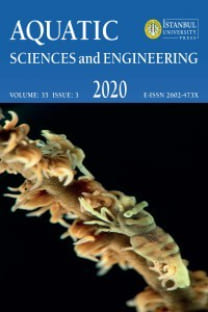Light and Scanning Electron Microscopic Observations on Grillotia erinaceus (Cestoda: Trypanorhyncha)
In the present study, the plerocercoids of Grillotia erinaceus were obtained from the wall of the anterior oesophagus, stomach, pyloric caeca and liver of teleost Black Sea whiting Merlangius merlangus and adults were collected from the intestine of elasmobranch thornback rays Raja clavata caught by commercial fishing vessels off Sinop, Turkey. Standard parasitological investigation methods were applied and morphological diagnostic features of the whole parasite, bothria, scolex, tentacular armatures and tentacles were studied in detail using a light and Scanning Electron Microscope (SEM). The plerocercoids of this parasite had a total length of 5.96 mm on average and this was 21.6 mm on average in adults. The measurement data of all morphological diagnostics are provided and photomicrographs of each part of the parasite are presented. This study also provides the detailed morphological features of both plerocercoids and adults of G. erinaceus in M. merlangus and R. clavata for the first time in the Turkish coasts of the Black Sea.
Keywords:
Grillotia erinaceus, Merlangius merlangus, Raja clavata, black sea,
___
- Beveridge, I. & Campbell, R. A. (2007). Revision of the Grillotia erinaceus (van Beneden, 1858) species complex (Cestoda: Trypanorhyncha), with the description of G. brayi n.sp. Systematic Parasitology, 68, 1–31. [CrossRef]
- Brickle, P., MacKenzie, K. & Pike, A. (2006). Variations in the parasite fauna of Patagonian toothfish (Dissostichus eleginoides Smith, 1898), with length, season and depth of habitat around the Falkland Island. Journal of Parasitology, 92(2), 282–291. [CrossRef]
- Chubb, J. C., Pool, D. W, & Veltkamp, C. J. (1987). A key to the species of cestodes (tapeworms) parasitic in British and Irish freshwater fishes. Journal of Fish Biology, 31, 517-543. [CrossRef]
- Deardorff, T. L., Raybourne, R. B. & Mattis, T. E. (1984). Infections with trypanorhynch plerocerci (Cestoda) in Hawaiian fishes of commercial importance. Sea Grant Quarterly, 6, 1-6.
- Dollfus, R. P. (1942). Études critiques sur les Tétrarhynques du Museum de Paris. Archives du Muséum national d´ Histoire natürelle, 19, 1–466.
- Jones, M. K., Beveridge, I., Campbell, R. A. & Palm, H. (2004). Terminology of the sucker-like organs of the scolex of trypanorhynch cestodes. Systematic Parasitology, 59, 121–126. [CrossRef]
- Kornyushin, V. V. & Solonchenko A. I. (1978). Redescription of the cestodes Grillotia erinaceus (Beneden, 1858) and Christianella minuta (Beneden, 1849) from Chondrostei in the Black Sea. Biologiya Morya, 45, 26–33 (in Russian).
- Lubieniecki, B. (1976). Aspects of the biology of the plerocercoid of Grillotia erinaceus (van Beneden, 1858) (Cestoda: Trypanorhyncha) in haddock Melanogrammus aeglefinus (L.). Journal of Fish Biology, 8, 431–439. [CrossRef]
- Menoret, A. & Ivanov, V. A. (2012). Description of plerocerci and adults of a new species of Grillotia (Cestoda: Trypanorhyncha) in teleosts and elasmobranchs from the Patagonian shelf off Argentina. Journal of Parasitology, 98(6), 1185-1199. [CrossRef]
- Özer, A., Öztürk, T., Kornyushin V., Kornyychuk, Y. & Yurakhno, V., (2012). Light and Scanning Electron Microscopic Observations on Grillotia erinaceus (van Beneden, 1858) (Cestoda:Trypanorhyncha) plerocercoids in whiting, Merlangius merlangus (L., 1758). XI. European Multicolloquium of Parasitology (EMOP XI), 24-29 July 2012, Cluj-Napoca, Romania.
- Özer, A., Öztürk, T., Kornyushin, V., Kornyychuk, Y. & Yurakhno, V. (2014). Grillotia erinaceus (van Beneden, 1858) (Cestoda: Trypanorhyncha) from whiting in the Black Sea, with observations on seasonality and host-parasite interrelationship. Acta Parasitologica, 59(3), 420-425. [CrossRef]
- Palm, H. W. (2004). The Trypanorhyncha Diesing, 1863. PKSPL-IPB Press, Bogor, x+710 pp
- Palm, H. W. & Caira, J. N. (2008). Host specificity of adult versus larval cestodes of the elasmobranch tapeworm order Trypanorhyncha. International Journal for Parasitology, 38, 381–388. [CrossRef]
- Palm, H. W. & Klimpel, S. (2007). Evolution of the parasitic life in the Ocean. Trends in Parasitology, 23, 10–12. [CrossRef]
- Palm, H. W., Waeschenbach, A., Olson, P. D. & Littlewood, D. T. J. (2009). Molecular phylogeny and evolution of the Trypanorhyncha Diesing, 1863 (Platyhelminthes: Cestoda). Molecular Phylogenetics and Evolution, 52, 351–367. [CrossRef]
- Palm, H. W., Yulianto, I. & Piatkowski, U. (2017). Trypanorhynch Assemblages Indicate Ecological and Phylogenetical Attributes of Their Elasmobranch Final Hosts. Fishes, 2(8), 1-16. [CrossRef]
- Shively, S, & Miller, W. R. (2009). The use of HMDS (hexamethyldisilazane) to replace Critical Point Drying (CPD) in the preparation of tardigrades for SEM (Scanning Electron Microscope) Imaging. Transactions of the Kansas Academy of Science, 112 (3-4), 198–200. [CrossRef]
- Tepe, Y., Oğuz, M. C. & Heckmann, R. A. (2014). Digenean and cestode parasites of teleost fish from the Eastern Black Sea Region. Turkish Journal of Zoology, 38, 209-215. [CrossRef]
- Yayın Aralığı: Yılda 4 Sayı
- Başlangıç: 1987
- Yayıncı: İstanbul Üniversitesi
Sayıdaki Diğer Makaleler
Ahmet ÖZER, Türkay ÖZTÜRK, Sevilay OKKAY, Violetta YURAKHNO, Julia KORNYYCHUK
